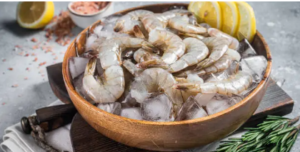Frozen Seafood: Frozen Seafood Offers Taste, Convenience and Sustainability
Many consumers are rethinking their “fresh is best” seafood mantra, turning to options in the freezer case that offer taste, convenience and sustainability. One such option is the Northern Chef line from Tai Foong USA.
When choosing frozen, ready-to-cook seafood, look for products with minimal surface ice and an inner package that keeps it moist and fresh. Then, cook the seafood as directed. For more information about frozen ready-to-cook seafood, click here.
Quality
 Frozen seafood can be high quality when sourced from a trusted source. The freezing process preserves the nutrients and texture of seafood and provides year-round availability and variety. However, frozen seafood gets a bad reputation from the copious amounts of heavily breaded fish sticks crowding freezer aisles.
Frozen seafood can be high quality when sourced from a trusted source. The freezing process preserves the nutrients and texture of seafood and provides year-round availability and variety. However, frozen seafood gets a bad reputation from the copious amounts of heavily breaded fish sticks crowding freezer aisles.
When selecting frozen seafood, look for labels that indicate how it was frozen. A good choice is FAS or Frozen at Sea, which means the seafood was frozen directly on board the vessel, preserving its freshness.
The best-frozen seafood comes from reputable suppliers that use quick freezing methods, which minimizes damage to the food’s cells. Also, check for signs of a closed moisture-proof package, and avoid packages that show signs of freezer burn or ice crystals. You can also test the quality of a frozen shellfish by doing a tap test: if it’s alive, its shell will close when tapped. If not, select a different item.
Freshness
According to Bon Appetit, most seafood on display at a fish counter or even in a grocery store has likely been frozen at some point. It is good since fresh fish in a display case may have been out of the water and in transit for several days before arriving at the seafood counter. For more information about frozen ready-to-cook seafood, click here.
Seafood should be kept on ice, in the refrigerator soon after purchase, and in the freezer if you plan to use it immediately. It should smell fresh and mild, not fishy or rancid. Whole fish should have clear eyes and bright red gills, and fillets should feel firm and springy, not mushy. Live shellfish should close when tapped, and crabs and lobsters should move their legs when handled.
When cooking frozen seafood, don’t try to speed up the thawing process by using warm water or placing it in a running faucet, which can cause harmful bacteria to grow. Instead, thaw seafood in the refrigerator overnight or put it in a bowl of cool water.
Convenience
Frozen seafood is often pre-cleaned and pre-portioned, which can reduce meal prep time. Additionally, frozen seafood typically has a longer shelf life than fresh fish and is less likely to spoil.
In a supermarket taste-testing study, consumers reported purchasing seafood with specific meals in mind. In contrast, when buying without planning, frozen products were more valued (see O’Donnell et al., 2017). The ease of cooking directly from freezing is a significant benefit.
The wide range of globally available seafood species has also increased the appeal of frozen seafood. Seafood can be purchased in supermarkets year-round, even when local varieties are out of season. It allows seafood lovers to enjoy a variety of seafood dishes regardless of their location or the season, reduces food waste, and reduces the Earth’s carbon footprint. Unlike fresh seafood that is flown to markets from distant ports, the vast majority of frozen seafood is sourced and consumed locally.
Value
Frozen seafood is a supermarket revenue driver. Consumers are increasingly purchasing frozen seafood, especially as new technologies make it taste more like its fresh counterpart and supermarkets expand merchandising options.
Manufacturers of frozen ready-to-cook seafood can capitalize on these trends by introducing product lines that meet consumers’ growing preference for healthy foods and their desire to reduce food waste. They can also appeal to millennial buyers by offering high-protein, low-calorie options that fit their health and wellness goals.
Frozen seafood can also be a good option for dietitians who want to offer their clients and patients sustainably sourced seafood. By choosing frozen seafood with a logo that indicates the seafood is from a sustainable fishery, dietitians can support ocean conservation efforts while promoting the health benefits of eating a variety of nutritious seafood.
